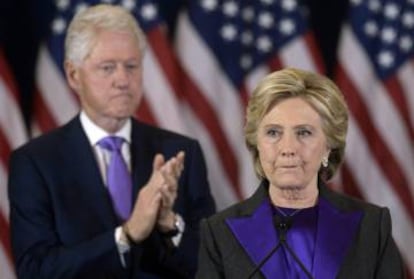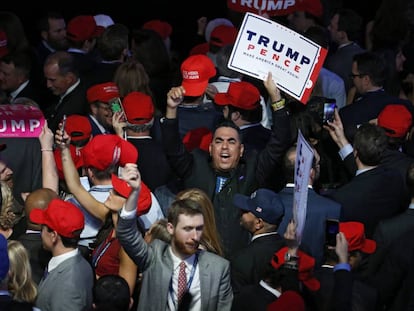Sexism was the winner
If a portrait of a woman hangs inside the White House, it will be as first lady, not as US President
It is clear by now that the United States was willing to open the doors of the White House to an African American, but not to a woman. A lot of racial wounds may have been healed during Barack Obama¡¯s eight-year tenure, but gender wounds are still open and bleeding profusely. There is no other explanation for the fact that the same nation that was bold enough to give Obama a well-deserved opportunity in 2008 has now preferred an extravagant mogul without the necessary education or experience over the best-prepared candidate in the entire electoral history of the United States ¨C one who also happens to be a woman.

Last Tuesday, Donald Trump obtained fewer ballots than John McCain in 2008 or Mitt Romney in 2012. Hillary Clinton managed 445,000 more votes than Trump, but not with the kind of distribution that would have ensured her victory. With the vote count over, it has emerged that it¡¯s not just middle- and low-income whites who decisively supported Trump: it¡¯s also that a vast proportion of the Hispanic and black minorities did not even show up to vote for the Democratic candidate.
We cannot even talk about any kind of gender solidarity: 53% of white women voted for Trump (as did 32% of Hispanic women and 6% of African-American women).
Gossip magazines are brimming with accounts of Trump¡¯s own infidelities
It did not matter that Trump and his acolytes¡¯ misogynous attacks, at their lowest, verged on the slanderous. Rudy Giuliani, who was mayor of New York City during the 9/11 attacks and who could soon be heading the Justice Department, stated in September that if Clinton did not realize her husband was cheating on her with Monica Lewinsky, then ¡°she¡¯s too stupid to be president.¡±
In October, Trump decided there would be nothing wrong with making his opponent¡¯s personal life a central point of his campaign, and used a televised rally to accuse her of cheating on her husband: ¡°I don¡¯t even think she¡¯s loyal to Bill, if you want to know the truth.¡±
Gossip magazines are brimming with accounts of Trump¡¯s own infidelities, which could fill entire books. But Clinton did not resort to them. Instead, she focused on her own proposals for a better country: making progress on health reform, reinforcing social security, immigration reform, the protection of minorities, and equal rights.
While she talked about economic policy and social reform at her rallies, the media ran shocking recordings of Trump calling a Hispanic model ¡°Miss Piggy¡± because of her weight, or boasting that he can grab women¡¯s private parts whenever he wants to because he is famous. And when he was accused of sexual abuse, his reply was that the accusers were ¡°too ugly¡± for him to take any notice of.

Still and all, Clinton lost five million votes compared with Obama in 2012. There are several possible explanations for this: her role in her husband¡¯s foundation, her alleged physical frailty and advanced age; her relationship with wealthy donors or the use of a private email server when she was secretary of state.
Trump attacked Clinton¡¯s character, describing her as ¡°dishonest,¡± ¡°a liar¡± and ¡°disgusting.¡±
In fact, most criticism against Hillary Clinton did not focus on her actual preparation for the job. The fact that she holds a bachelor¡¯s degree from the prestigious Wesleyan College and a graduate degree in law from Yale, that she has built a successful career as a lawyer, been an admired senator and an efficient secretary of state ¨C none of this mattered. Not even the fact that as First Lady she did not resign herself to serving tea and tending the garden, but instead pushed forward health reforms that would take more than a decade before getting passed.
Her main hurdle is her own surname: Clinton.
When Clinton was born in 1947, there were only eight women in Congress: Now there are 84
And there is nothing more unfair than describing her through the person that she is married to, rather than through her personal skills. She has become an appendix, a footnote. Trump adopted the right strategy, portraying her as the treacherous consort of a corrupt, unscrupulous family clan. Nobody paid attention to her proposals, just to her image and to her family.
When Clinton was born in 1947, there were only eight women in a Congress with 435 seats. Today, they don¡¯t even represent a fourth of the chamber: 84 seats, or 19%. The situation in the Senate is similar. When the candidate was born, there was not a single woman senator, while there are now 21 out of 100.
Two female vice-presidential nominees came close to the White House: the Democrat Geraldine Ferraro in 1984 and the Republican Sarah Palin in 2008. And now, Hillary Clinton joins the list of women who tried to shatter the glass ceiling but were unable to, because the message from half of American voters was clear: if a woman¡¯s portrait has to hang inside the White House, it must be merely as the first lady.
English version by Susana Urra.
Tu suscripci¨®n se est¨¢ usando en otro dispositivo
?Quieres a?adir otro usuario a tu suscripci¨®n?
Si contin¨²as leyendo en este dispositivo, no se podr¨¢ leer en el otro.
FlechaTu suscripci¨®n se est¨¢ usando en otro dispositivo y solo puedes acceder a EL PA?S desde un dispositivo a la vez.
Si quieres compartir tu cuenta, cambia tu suscripci¨®n a la modalidad Premium, as¨ª podr¨¢s a?adir otro usuario. Cada uno acceder¨¢ con su propia cuenta de email, lo que os permitir¨¢ personalizar vuestra experiencia en EL PA?S.
?Tienes una suscripci¨®n de empresa? Accede aqu¨ª para contratar m¨¢s cuentas.
En el caso de no saber qui¨¦n est¨¢ usando tu cuenta, te recomendamos cambiar tu contrase?a aqu¨ª.
Si decides continuar compartiendo tu cuenta, este mensaje se mostrar¨¢ en tu dispositivo y en el de la otra persona que est¨¢ usando tu cuenta de forma indefinida, afectando a tu experiencia de lectura. Puedes consultar aqu¨ª los t¨¦rminos y condiciones de la suscripci¨®n digital.










































